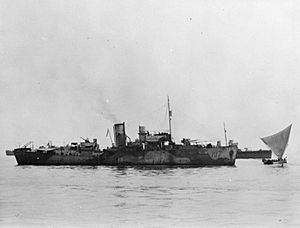HMS Amaranthus (K17) facts for kids

HMS Amaranthus
|
|
Quick facts for kids History |
|
|---|---|
| Name | HMS Amaranthus |
| Ordered | 21 September 1939 |
| Builder | Fleming & Ferguson, Paisley |
| Laid down | 4 May 1940 |
| Launched | 17 October 1940 |
| Commissioned | 12 February 1941 |
| Decommissioned | 1946 |
| Identification | Pennant number: K17 |
| Fate | Sold in 1946. Broken up at Hong Kong in 1953. |
| General characteristics | |
| Class and type | Flower-class corvette |
| Displacement | 925 long tons |
| Length | 205 ft (62 m) o/a |
| Beam | 33 ft (10 m) |
| Draught | 11 ft 6 in (3.51 m) |
| Propulsion |
|
| Speed | 16 kn (30 km/h) |
| Range | 3,500 nmi (6,500 km) at 12 kn (22 km/h) |
| Complement | 85 |
| Sensors and processing systems |
|
| Armament |
|
| Service record | |
| Commanders: | Lt. Nicholas Bryan John Stapleton, RNR (January 1941 to August 1941); T/Lt. Walter Smith Thomson, RNR (August 1941 to June 1943); T/A/Lt.Cdr. William Godfrey Pardoe-Matthews, RNR (June 1943 to November 1944); T/A/Lt.Cdr. John Maurice Baldry, RNVR, (November 1944 to decommissioning) |
| Operations: | Battle of the Atlantic |
HMS Amaranthus (K17) was a special type of ship called a Flower-class corvette that served in the Royal Navy during the Second World War. These ships were like small, tough warships designed to protect other ships. Amaranthus played an important role by helping to escort convoys, which are groups of merchant ships, safely across the ocean from West Africa to the United Kingdom starting in May 1941. This was a very dangerous job because of enemy submarines.
Contents
Building a Warship: HMS Amaranthus
Why Flower-Class Corvettes Were Needed
In the late 1930s, the Royal Navy realized it didn't have enough ships to protect its coasts. War with Germany seemed likely. They especially needed smaller ships to guard the eastern coast of Britain. To solve this problem quickly, they looked for a simple ship design.
A Clever Design for Protection
The solution was to base a warship on a whale-catcher ship called Southern Pride. This design was much better than older Naval trawlers. It was also cheaper and faster to build than larger warships like Hunt-class destroyers. This made the Flower-class corvettes perfect for protecting convoys.
Amaranthus's Size and Power
Amaranthus and other early Flower-class ships were about 205 ft (62 m) long. They were 33 ft (10 m) wide. These ships weighed about 940 long tons (960 t). They had a powerful engine that could make 2,750 indicated horsepower (2,050 kW) of power. This allowed them to reach a top speed of 16 kn (30 km/h). They could travel about 4,000 nmi (7,400 km) without needing to refuel.
Weapons for Defense
The main weapon on Amaranthus was a large BL 4-inch Mk IX naval gun at the front. It also had a 2-pounder anti-aircraft cannon at the back. However, these cannons were not ready until 1941. So, early ships like Amaranthus used other guns for close-range defense. These included Lewis guns or Vickers .50 machine guns.
Building Amaranthus
The British Navy ordered ten Flower-class corvettes on September 21, 1939. Amaranthus was one of them. It was built at the Fleming and Ferguson shipyard in Paisley, Scotland. Construction began on May 4, 1940. The ship was launched into the water on October 17, 1940. It was fully finished and ready for service on February 12, 1941.
Wartime Service: Protecting Convoys
Amaranthus played a vital role in the Battle of the Atlantic. This was a long fight to protect ships carrying supplies across the ocean. From May 1941, Amaranthus helped escort convoys. These convoys traveled from West Africa to the United Kingdom. This job was very important for the war effort. It ensured that food, fuel, and other supplies reached Britain safely.
Life After War
After the Second World War ended in 1945, Amaranthus was no longer needed by the Royal Navy. The ship was officially taken out of service in 1946. It was then sold. Eventually, in 1953, Amaranthus was taken apart for scrap metal in Hong Kong.
Sources

